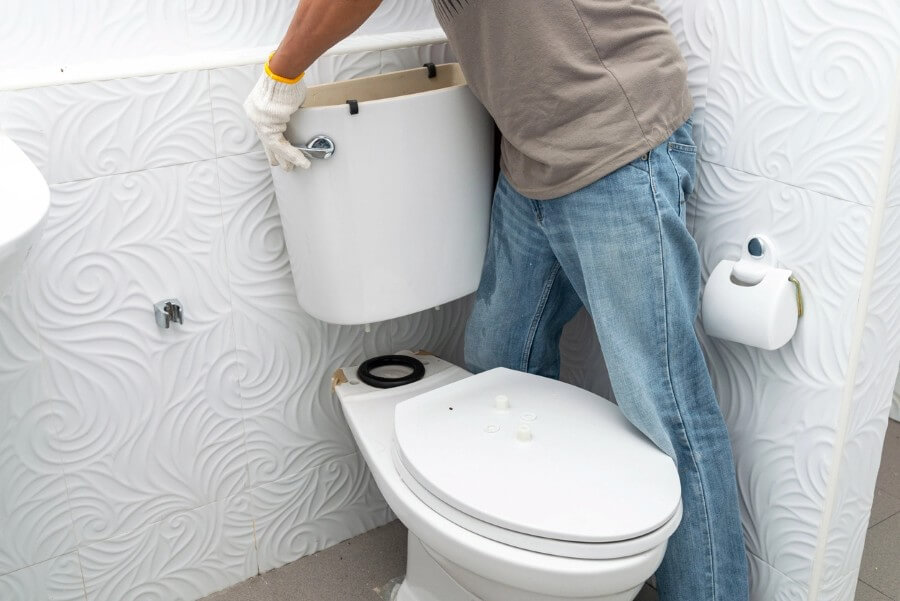Toilets 101: How Your Toilet Works and What to Check Before You Call a Plumber

It’s easy to take toilets for granted, but this essential bathroom fixture—often called the ‘porcelain throne’—plays a vital role in daily comfort and hygiene. After all, toilets rule our lives! When your toilet stops working the way you expect, it can wreak havoc on your whole household. That’s why it’s important to understand how your toilet works.
From the flapper to the flush valve, every part of your toilet plays its part in keeping your plumbing running smoothly. By learning about these parts, you’ll know the warning signs that something is amiss. You’ll also know which common toilet plumbing problems you can repair yourself – and when you should call in the pros.
Toilet Anatomy: Know Your Parts
Although there are many different types of toilets, they all involve two core sections: the tank and the bowl. The tank is the upper section, which stores water used for flushing, as well as the flushing components that release this water when you press the handle. The bowl, meanwhile, is the lower section that captures waste.
Toilet Tank Parts
Toilet tank parts include:
The handle (also known as the trip lever): What you push to start a flush.
The flapper and lift chain: The flapper seals the hole at the bottom of the tank. When you push the handle or trip lever, it pulls the chain and lifts the flapper. This releases tank water into the bowl.
Flush valve and overflow tube: The flush valve is the pathway for water during a flush, and the overflow tube prevents tank overflow by directing excess water into the bowl.
Fill valve and refill tube: After a flush, the fill valve refills the tank. A small refill tube sends water into the bowl to restore the bowl level.
Float: The float controls the water level in the tank by signaling the fill valve to stop filling.
Tank-to-bowl gasket, shut-off valve, and water supply line: These parts prevent leaks and control the water feed.
Toilet Bowl Parts
Toilet bowl parts include:
The seat and lid: The seat is where you sit when using the toilet, and the lid covers it when not in use. Designed for comfort and function, they are available in different sizes and sometimes include room for a bidet attachment.
The bowl rim and trapway: The bowl’s rim is a thicker section of porcelain with strategically-positioned holes that direct water when flushing. The trapway is the curved channel that moves water and waste into the sewer line.
Wax ring and flange: The wax ring seals the toilet base to the flange on the floor and the sewer pipe. If you experience leaks at the base of your toilet bowl, or a foul smell of sewer gas, it’s usually a sign that your wax ring or flange need replacing.
Closet bolts: These bolts secure the toilet bowl to the flange and the floor.
Common Toilet Plumbing Problems
There are almost as many different kinds of plumbing problems as there are types of plumbing fixtures! However, many toilet problems are more common than others. Often, these common toilet problems are easy to repair with a DIY fix.
Toilet Won’t Stop Running
Ever flush your toilet, leave the room, then realize it’s still running minutes later? This means your flapper isn’t sealing properly, or your tank’s float may be set too high, causing spillage into the overflow tube.
While jiggling the handle often stops excess running, this issue is relatively easy to DIY repair. Replacement flappers and floats are inexpensive and widely available at most home improvement stores.
Weak Flushing and Clogs
If your flush feels weaker than usual, check the bowl’s rim holes. Over time, these holes can become blocked with mineral deposits that reduce their flow. Clean them with a brush or with a small wire, such as a straightened coat hanger, to restore flushing power. You can also use an acidic toilet bowl cleanser or a vinegar-based solution to dissolve stubborn mineral deposits.
Clogs can also affect the flow of water and waste from your toilet bowl to the sewer. If your trapway is blocked, use a plunger to clear or dislodge the blockage. However, if plunging isn’t effective, you’ll likely need to call a professional plumber.
A Wobbly Base
Feeling a little wobbly when you sit? That’s not a great sign. If your toilet is loose or rocks slightly from side-to-side, it probably has a broken flange, a bad wax ring, or loose closet bolts. The good news is that these issues are relatively simple to repair.
For loose bolts, tighten them carefully with a wrench – but avoid going too tight to avoid cracking the base. If the wobble continues and you smell sewage, replace the wax ring. That’s a slightly bigger job, but still manageable for handy homeowners.
When to Call a Plumber for Toilet Problems
Often, plumbing problems appear simple on the surface but actually require a complicated repair – and sometimes a DIY fix can make these issues even worse! So when should you put down the plunger and call a professional plumber to handle your toilet troubles?
Water Pooling at the Base
If you’ve replaced the wax ring and tightened the closet bolts, but still have frequent leaks or water pooling at the base of your toilet bowl, it’s a sign that the flange itself may be damaged. If your flange is cracked or the drain pipe sits below floor level, you’ll need a professional plumber with the right tools and materials to resolve this issue.
Cracks in the Porcelain
If you notice any cracks in your toilet bowl or tank – even if they’re hairline – this is a major problem you can’t repair on your own. Ignoring cracks risks a sudden flood if the porcelain fails. A plumber can determine whether the toilet is safe to keep using for a while or if it’s time for a full toilet replacement.
Flange or Drain Line Damage
If your flange is broken, misaligned, or sitting too low, you may end up with constant leaks or poor flushing performance. Drain line issues, like partial blockages or corrosion, often require specialized equipment (such as augers or cameras) to diagnose and fix. Unfortunately, these are not “trial and error” home-handyman jobs because guesswork can make these issues worse.
Treat Your Toilet Right!
A well-functioning toilet is essential to any home, and keeping it that way starts with knowing how it works. Get familiar with its key parts and common problems so you can tackle issues before they turn into costly repairs.The next time your toilet runs, wobbles, or won’t flush, you will know what to look for, how to rule out the easy stuff, and when to call a pro – like Rocket Plumbing. Call 773-299-1600 or learn more about our toilet repair services online.

